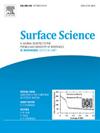Boronic acid adsorption on TiO2 rutile (110): A DFT+U study
IF 2.1
4区 化学
Q3 CHEMISTRY, PHYSICAL
引用次数: 0
Abstract
Surface modification of TiO2 is crucial in many optoelectronic applications, such as in dye-sensitized solar cells (DSSCs), where anchoring groups facilitate the covalent binding of dye molecules to nanocrystalline TiO2. Anchoring groups affect the stability of the linkage and the electronic coupling between the semiconductor and dye sensitizer, thus influencing the efficiency of the DSSC. In this study, we explore boronic acids as a novel alternative to commonly used anchoring groups. We investigate the optimization of the stability of boronic acids anchored on the TiO2 rutile (110) surface through the introduction of various functional groups, specifically methyl, phenyl, and fluorophenyl. This fully computational study employs density functional theory with the DFT+U Hubbard correction and D3 dispersion corrections. A range of molecular and dissociative adsorption structures are analyzed to determine the dominant mode of adsorption. Additionally, adsorption is modeled on multiple surface sizes to assess the impact of surface coverage on adsorbate configuration and adsorption energy. We find that using the larger surface cell is necessary to obtain reliable adsorption energies. The bidentate doubly dissociated configuration is identified as the dominant mode of adsorption. Adsorption is strengthened with the introduction of functional groups, most notably with the phenyl groups. Our findings suggest that boronic acids are a viable alternative to conventional anchoring groups.
二氧化钛金红石(110)上硼酸吸附的DFT+U研究
TiO2的表面修饰在许多光电应用中是至关重要的,例如在染料敏化太阳能电池(DSSCs)中,锚定基团促进染料分子与纳米TiO2的共价结合。锚定基团影响了半导体与染料敏化剂之间的连接稳定性和电子耦合,从而影响了DSSC的效率。在这项研究中,我们探索硼酸作为一种新的替代常用的锚定基团。通过引入不同的官能团,特别是甲基、苯基和氟苯基,我们研究了硼酸锚定在TiO2金红石(110)表面的稳定性优化。这个完全计算的研究采用密度泛函理论与DFT+U哈伯德校正和D3色散校正。分析了一系列分子和解离吸附结构,以确定主要的吸附模式。此外,吸附模拟了多种表面尺寸,以评估表面覆盖对吸附质构型和吸附能的影响。我们发现,为了获得可靠的吸附能,必须使用更大的表面电池。双齿双解离结构被确定为主要的吸附模式。随着官能团的引入,尤其是苯基的引入,吸附作用得到加强。我们的研究结果表明,硼酸是一种可行的替代传统锚定基团。
本文章由计算机程序翻译,如有差异,请以英文原文为准。
求助全文
约1分钟内获得全文
求助全文
来源期刊

Surface Science
化学-物理:凝聚态物理
CiteScore
3.30
自引率
5.30%
发文量
137
审稿时长
25 days
期刊介绍:
Surface Science is devoted to elucidating the fundamental aspects of chemistry and physics occurring at a wide range of surfaces and interfaces and to disseminating this knowledge fast. The journal welcomes a broad spectrum of topics, including but not limited to:
• model systems (e.g. in Ultra High Vacuum) under well-controlled reactive conditions
• nanoscale science and engineering, including manipulation of matter at the atomic/molecular scale and assembly phenomena
• reactivity of surfaces as related to various applied areas including heterogeneous catalysis, chemistry at electrified interfaces, and semiconductors functionalization
• phenomena at interfaces relevant to energy storage and conversion, and fuels production and utilization
• surface reactivity for environmental protection and pollution remediation
• interactions at surfaces of soft matter, including polymers and biomaterials.
Both experimental and theoretical work, including modeling, is within the scope of the journal. Work published in Surface Science reaches a wide readership, from chemistry and physics to biology and materials science and engineering, providing an excellent forum for cross-fertilization of ideas and broad dissemination of scientific discoveries.
 求助内容:
求助内容: 应助结果提醒方式:
应助结果提醒方式:


